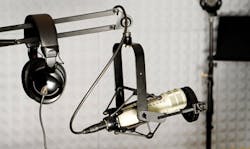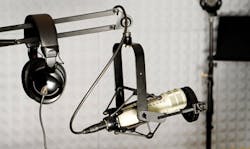On the radio
Dental hygienists hit the airwaves on Cross Link Radio
By Cathy Hester Seckman, RDH
I once read a novel about a housewife from the 1930s who broadcast a daily radio program from her living room called "Neighbor Dorothy." It sounded like a lot of work, and I wondered who would really want to do such a thing.
Well, it turns out that Shirley Gutkowski of Madison, Wisconsin, has wanted to be a radio host since she was 12 years old. Thanks to the popularity and accessibility of Internet talk radio, she has finally gotten her wish. While working on another project with Diana Corbin of Virginia early in 2012, the two hygienists started talking about developing a talk radio show of their own. The show, they thought, should run daily, and should not only include oral health information, but lifestyle topics as well.
------------------------------------------------------------------
Other articles by Seckman
- Not a tech geek: This crash course offers a glimpse of how technology will impact the hygiene operatory
- At the hands of a student: Veterans return to hygiene school for treatment
- In Favor of Invisible: The popularity of nearly invisible orthodontic appliances enhances treatment options
------------------------------------------------------------------
Radio stations that present news, talk, and information are on the increase, according to the Pew Research Center. There were 2,634 such stations in 2008; 3,446 in 2009; and 3,795 in 2010. Older listeners make up most of the audience at 34%. Between 2008 and 2011, the time the average person spent listening to online radio increased from about six hours a week to more than nine and a half hours a week. Some 89 million Americans listened to online audio services in one month in 2011, according to Pew.
Shirley started investigating talk radio websites, and settled on BlogTalkRadio (BTR), which she says is friendly and very well set up, with a professional platform. BTR calls itself the largest social radio network, with millions of listeners and thousands of hosts covering politics, tech, entertainment, health, and more. They claim 1,800 shows a day, 15,000 active hosts, and 40 million listens per month.
Shirley and Diana set to work last February, learning as they went and spending many, many hours setting up their show, Cross Link Radio. Shirley is the host, and Diana was the original executive producer. Hygienist Carla Ganz has also been involved in production.
The 30-minute show went live March 17, 2013, and has continued five days a week since then. Their topics have included nutrition and oral health, autism, oral cancer, social media etiquette, and communication, among many others, covering topics from health to leisure.
Monday programs involve the business of dental hygiene; Tuesdays have topics focused on inflammation; on Wednesdays, Shirley and guests talk about wellness; and on Thursdays, about biofilm. The popular Friday programs are devoted to hobbies. When hygienist Liz Nies came on the show last May to talk about fly-fishing, for instance, more than 10,000 listeners logged in. Their most popular program to date was presented by Diana in June, when 27,610 listeners heard a program on oral cancer. The first two-hour special, on autism, drew more than a thousand listeners.
Shirley has experimented with advertising spots during each program, offering the time without cost to CAREERfusion partners so they can practice the mechanics of inserting the spots. "We wanted to be sure that we didn't accidentally skip a commercial that was paid for," says Shirley. "We're pleased to say that we are mistake free now." Eventually they'll be able to sell paid advertising spots during the show.
There's not a lot of equipment required, surprisingly. All you need, according to the BTR site, is a phone and a computer. Shirley also uses a headset microphone. Shirley, Diana, and their interviewees are rarely in the same location, or even the same section of the country. Diana might be in her car in Virginia, Shirley in a hotel room in Oregon, and the interviewee at home in California or Texas or Ohio. During the Under One Roof conference in July, Shirley recorded from her hotel room every day at 4 a.m. to meet the 8 a.m. Eastern airtime. Diana was in the hall outside her own hotel room, so as not to wake her roommates.
To set up each show, Shirley says, "We start with a topic. If needed, we have a guest to elaborate and explain things. Then we gather photos and information from the guest and use that intel to set up the show on the BTR platform. We use Twitter, Facebook, LinkedIn, and discussion groups like AmyRDH.com to advertise the program."
Diana has left the team, due to other work commitments, and has been replaced by other CAREERfusion hygienists learning the ropes of radio show production. Laurie Samuels produces the Wednesday wellness program, Jen Kirkham produces the Friday hobby show, and Gaylene Baker leads the week producing the Monday program. Each identifies a topic and guest to speak on the topic. They each set up the show on the radio platform and give Shirley bits and parts to make the interview go smoothly.
Producing, according to Shirley, "means the producer is gathering marketable skills in networking, writing, organizing, and communicating. The producers have to think outside the networking box by finding a guest who will be interesting to listeners, not just someone they know. Producers need to gather the right kind of information that will make the guest and the host look really good and smart.
"They put all the pieces into a shared folder, and go through the steps of getting the show set up on the platform. On the day of the show, the producer makes sure the guest is ready and online, and plays the predetermined commercials and music during the show. She then contacts the guest after the program to say goodbye. Producers also do a little show promotion as well. As they evolve in their jobs, the producers will become sales agents for the show, getting advertisers and potentially cutting commercials themselves."
The average audience per show, Shirley says, is about 300 archived listens. It takes a week for a show to reach that number, since people download the shows for later listening or listen later online if they can't catch it during the live air time, 8 a.m. Eastern. BTR collects statistics for the shows, reporting that the majority of people listen from the computer, while just 1% listen on their phones.
"The largest number of listens," Shirley adds, "has come from the shows that were featured as Staff Picks on the BTR platform. We submit them there."
The team is actively scouting for people to be on the show. Listeners are always encouraged to suggest topics they'd like to hear.
Cross Link Radio is here, http://www.blogtalkradio.com/crosslinkradio, every Monday through Friday at 8 a.m. Eastern time. Every previous show is also archived at the website, and the archived shows are now available at www.stitcher.com and iTunes.
CATHY HESTER SECKMAN, RDH, worked as a hygienist for 32 years, including 11 years in pediatric dentistry. She is a frequent contributor to dental magazines, works as an indexer, and is the author of three novels and more than a dozen short stories. Contact her at [email protected].
Past RDH Issues

